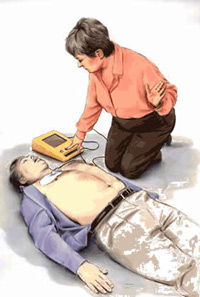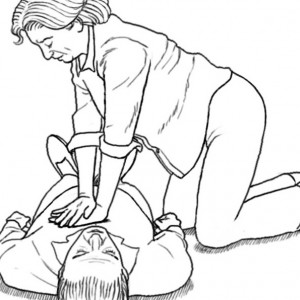 There are 220,000 victims of sudden cardiac arrest per year in the United States; about 10,000 sudden cardiac arrests occur at work.
There are 220,000 victims of sudden cardiac arrest per year in the United States; about 10,000 sudden cardiac arrests occur at work.
Waiting for the arrival of emergency medical system personnel results in only 5-7% survival.
Studies with immediate defibrillation have shown up to 60% survival one year after sudden cardiac arrest.
Automated external defibrillators
An automated external defibrillator (AED) is a medical device designed to analyze the heart rhythm and deliver an electric shock to victims of ventricular fibrillation to restore the heart rhythm to normal. Ventricular fibrillation is the uncoordinated heart rhythm most often responsible for sudden cardiac arrest.
Sudden cardiac arrest
Sudden cardiac arrest occurs when ventricular fibrillation takes place or when the heart stops beating altogether. Without medical attention, the victim collapses, loses consciousness, becomes unresponsive, and dies. Many victims have no prior history of heart disease and are stricken without warning.
Causes of sudden cardiac arrest
- Heart attack
- Electrocution
- Asphyxiation (loss of consciousness and death caused by inadequate oxygen in the work environment, such as in a confined space).
Reasons for AEDs in the workplace
- Workers may suffer sudden cardiac arrest while on the job.
- Onsite AEDs save precious treatment time, and can improve survival odds because they can be used before emergency medical service (EMS) personnel arrive.
- A heart rhythm in ventricular fibrillation may only be restored to normal by an electric shock.
- The AED is compact, lightweight, portable, battery operated, safe, and easy to use.
Placement of AEDs
- AEDs should be conveniently installed to ensure response within 3-5 minutes.
- Areas where many people work closely together, such as assembly lines and office buildings.
- Close to a confined space.
- Areas where electric-powered devices are used.
- Outdoor worksites where lightning may occur.
- Health units where workers may seek treatment for heart attack symptoms.
- Company fitness units and cafeterias.
- Remote sites, such as off-shore drilling rigs, construction projects, marine vessels, power transmission lines, and energy pipe lines.
AED program cost
AEDs cost $1200-$3000 per device. Training, annual retraining, and administrative costs are additional.
AED training
Your workers can easily be trained to:
- Recognize sudden cardiac arrest and notify EMS personnel,
- Perform cardiopulmonary resuscitation (CPR),
- Provide early defibrillation with an AED, and
- Care for the victim until EMS personnel arrive.


